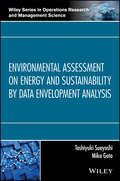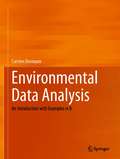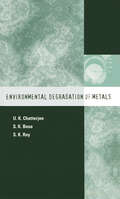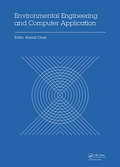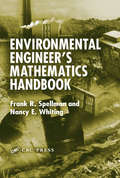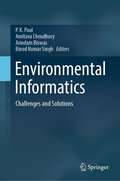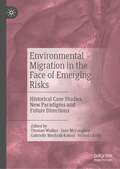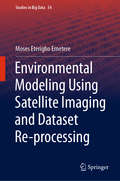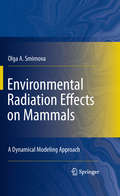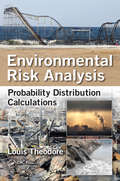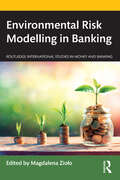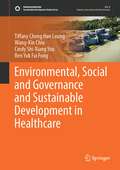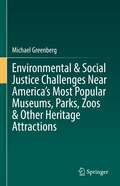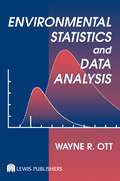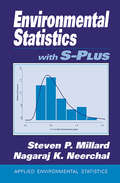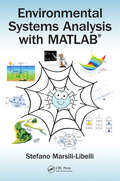- Table View
- List View
Environmental Assessment on Energy and Sustainability by Data Envelopment Analysis
by Toshiyuki Sueyoshi Mika GotoIntroduces a bold, new model for energy industry pollution prevention and sustainable growth Balancing industrial pollution prevention with economic growth is one of the knottiest problems faced by industry today. This book introduces a novel approach to using data envelopment analysis (DEA) as a powerful tool for achieving that balance in the energy industries—the world’s largest producers of greenhouse gases. It describes a rigorous framework that integrates elements of the social sciences, corporate strategy, regional economics, energy economics, and environmental policy, and delivers a methodology and a set of strategies for promoting green innovation while solving key managerial challenges to greenhouse gas reduction and business growth. In writing this book the authors have drawn upon their pioneering work and considerable experience in the field to develop an unconventional, holistic approach to using DEA to assess key aspects of sustainability development. The book is divided into two sections, the first of which lays out a conventional framework of DEA as the basis for new research directions. In the second section, the authors delve into conceptual and methodological extensions of conventional DEA for solving problems of environmental assessment in all contemporary energy industry sectors. Introduces a powerful new approach to using DEA to achieve pollution prevention, sustainability, and business growth Covers the fundamentals of DEA, including theory, statistical models, and practical issues of conventional applications of DEA Explores new statistical modeling strategies and explores their economic and business implications Examines applications of DEA to environmental analysis across the complete range of energy industries, including coal, petroleum, shale gas, nuclear energy, renewables, and more Summarizes important studies and nearly 800 peer reviewed articles on energy, the environment, and sustainability Environmental Assessment on Energy and Sustainability by Data Envelopment Analysis is must-reading for researchers, academics, graduate students, and practitioners in the energy industries, as well as government officials and policymakers tasked with regulating the environmental impacts of industrial pollution.
Environmental Chemometrics: Principles and Modern Applications
by Grady HanrahanMultivariate, heterogeneous data has been traditionally analyzed using the "one at a time" variable approach, often missing the main objective of discovering the relationships among multiple variables and samples. Enter chemometrics, with its powerful tools for design, analysis, and data interpretation of complex environmental systems. Delineating
Environmental Data Analysis: An Introduction with Examples in R
by Carsten DormannEnvironmental Data Analysis is an introductory statistics textbook for environmental science. It covers descriptive, inferential and predictive statistics, centred on the Generalized Linear Model. The key idea behind this book is to approach statistical analyses from the perspective of maximum likelihood, essentially treating most analyses as (multiple) regression problems. The reader will be introduced to statistical distributions early on, and will learn to deploy models suitable for the data at hand, which in environmental science are often not normally distributed. To make the initially steep learning curve more manageable, each statistical chapter is followed by a walk-through in a corresponding R-based how-to chapter, which reviews the theory and applies it to environmental data. In this way, a coherent and expandable foundation in parametric statistics is laid, which can be expanded in advanced courses.The content has been “field-tested” in several years of courses on statistics for Environmental Science, Geography and Forestry taught at the University of Freiburg.
Environmental Degradation of Metals: Corrosion Technology Series/14 (Corrosion Technology)
by U.K. Chatterjee S.K. Bose S.K. RoyThis highly practical reference presents for the first time in a single volume all types of environmental degradation a metallic compound may undergo during its processing, storage, and service. Clarifying general and localized corrosion effects, Environmental Degradation of Metals describes the effects of atmospheric exposure, high-temperature gas
Environmental Engineering and Computer Application: Proceedings of the 2014 International Conference on Environmental Engineering and Computer Application (ICEECA 2014), Hong Kong, 25-26 December 2014
by Kennis ChanThe awareness of environment protection is a great achievement of humans; an expression of self-awareness. Even though the idea of living while protecting the environment is not new, it has never been so widely and deeply practiced by any nations in history like it is today. From the late 90s in the last century, the surprisingly fast dev
Environmental Engineer's Mathematics Handbook: Null
by Frank R. Spellman Nancy E. WhitingAdvanced mathematics used in engineering is studied here in this text which examines the relationship between the principles in natural processes and those employed in engineered processes. The text covers principles, practices and the mathematics involved in the design and operation of environmental engineering works. It also presents engineering
Environmental Informatics: Challenges and Solutions
by P. K. Paul Amitava Choudhury Arindam Biswas Binod Kumar SinghThis interdisciplinary book incorporates various aspects of environment, ecology, and natural disaster management including cognitive informatics and computing. It fosters research innovation and discovery on basic science and information technology for addressing various environmental problems, while providing the right solutions in environment, ecology, and disaster management. This book is a unique resource for researchers and practitioners of energy informatics in various scientific, technological, engineering, and social fields to disseminate original research on the application of digital technology and information management theory and practice to facilitate the global transition toward sustainable and resilient energy systems. Cognitive informatics is also the need of the hour and deals with cutting-edge and multidisciplinary research area that tackles the fundamental problems shared by modern informatics, computation, software engineering, AI, cybernetics, cognitive science, neuropsychology, medical science, systems science, philosophy, linguistics, economics, management science, and life sciences, which this book also presents.
Environmental Migration in the Face of Emerging Risks: Historical Case Studies, New Paradigms and Future Directions
by Thomas Walker Victoria Kelly Jane McGaughey Gabrielle Machnik-KekesiThis book will provide a space for new and emergent research in environmental migration, particularly in the context of a world beginning to emerge from the grip of a debilitating public health crisis that kept many firmly rooted in place while displacing others internationally. With famines, vast wildfires, droughts, and record heatwaves uprooting human settlements internationally, research on migration in the face of emerging risks is all the more urgent. As Balsari, Dresser, & Leaning point out, “the wall-building, xenophobic, and insular” platforms of some global powers in their immigration and asylum policies, and the ever-increasing stresses placed on the natural world that continue to make sites of human settlement less and less hospitable, make research on this topic both very timely and much needed. This book will include numerous case studies, historical analyses, projections, models, and recommendations for both policy and future research directions. Contributions are drawn from academics and practitioners in this fertile interdisciplinary field of academic inquiry, and each one focuses on the intersection of population and environment studies, history, geography, law, diaspora studies, economics, public health, and sociology.This book is composed of five clear sections. The introductory section includes one chapter that presents an overview of the current landscape, the scope and objectives of the book, as well as its specific approach and the various themes. The concluding section is composed of one chapter that presents a global map of recent innovations drawing together some of the core themes discussed throughout the book. The concluding chapter synthesizes the challenges and opportunities presented, and the possible future directions that researchers, practitioners, and regulators could and should move towards.
Environmental Modeling Using Satellite Imaging and Dataset Re-processing (Studies in Big Data #54)
by Moses Eterigho EmetereThis book introduces methods of re-processing images to extract numerical information that can be used to quantify the observables in environmental modelling. Experiments or procedures that yield large images can be statistically or parametrically examined. Through the use of open source libraries, the book shows how ‘big data’ in the form of images or datasets can be comparatively analysed along same defined procedures or standards. This book helps to solve the challenges of discarding datasets that are relevant directly or indirectly to the research. The habit of screening datasets leads to the discard of over 90% of the original dataset or images generated in the experiments or procedure. If the images or datasets are generated under the same principles or conditions, then each measurement may be the narrative of unique events. The focus of this book is to enlighten researchers on how to analyse measurements with the aim of ensuring 100% utilization.
Environmental Radiation Effects on Mammals
by Olga A. SmirnovaThe monograph is devoted to theoretical studies of radiation effects on mammals. It investigates the effects of both acute and chronic irradiation on vital body systems (hematopoiesis, small intestine, and humoral immunity), on the development of autoimmune diseases and on the mortality dynamics in homogeneous and nonhomogeneous (in radiosensitivity) mammalian populations. All are set within the framework of biologically motivated mathematical models. The developed methodology of the studies, the models themselves, and the obtained results are of a great theoretical significance and can find wide practical use for those dealing with the problems of environmental protection and radiation safety.
Environmental Risk Analysis: Probability Distribution Calculations
by Louis TheodoreA Training Tool for the Environmental Risk ProfessionalEnvironmental Risk Analysis: Probability Distribution Calculations defines the role that probability distributions play in risk analysis, and gives direction on how to measure and compare the magnitude of risk more efficiently. Designed for the practicing environmental engineer and scientist, t
Environmental Risk Modelling in Banking (Routledge International Studies in Money and Banking)
by Magdalena ZiołoEnvironmental risk directly affects the financial stability of banks since they bear the financial consequences of the loss of liquidity of the entities to which they lend and of the financial penalties imposed resulting from the failure to comply with regulations and for actions taken that are harmful to the natural environment. This book explores the impact of environmental risk on the banking sector and analyzes strategies to mitigate this risk with a special emphasis on the role of modelling. It argues that environmental risk modelling allows banks to estimate the patterns and consequences of environmental risk on their operations, and to take measures within the context of asset and liability management to minimize the likelihood of losses. An important role here is played by the environmental risk modelling methodology as well as the software and mathematical and econometric models used. It examines banks’ responses to macroprudential risk, particularly from the point of view of their adaptation strategies; the mechanisms of its spread; risk management and modelling; and sustainable business models. It introduces the basic concepts, definitions, and regulations concerning this type of risk, within the context of its influence on the banking industry. The book is primarily based on a quantitative and qualitative approach and proposes the delivery of a new methodology of environmental risk management and modelling in the banking sector. As such, it will appeal to researchers, scholars, and students of environmental economics, finance and banking, sociology, law, and political sciences.
Environmental, Social and Governance and Sustainable Development in Healthcare (Sustainable Development Goals Series)
by Ben Yuk Fong Tiffany Cheng Leung Wang-Kin Chiu Cindy Shi-Xiang YouThis book applies environmental, social and governance (ESG) to issues of sustainable development in healthcare. ESG reporting has been widely used for some time in the business industry to show the economic, social and environmental responsibilities of companies that aim to achieve superior ESG performance for lower risk, more accountability and transparency. Moreover, public-listed companies in healthcare have been growing in significant numbers in recent years. The application or practice of ESG in healthcare has become a growing trend for these large organisations looking to demonstrate their strengths in areas of financing, operations, sustainability and social responsibilities. Such an approach is essential not only for the long-term development of the companies but also for services delivered by healthcare practitioners. Equally, the implications to Sustainable Development Goal (SDG) 3 is relevant to healthcare worldwide with a growing ageing population, which has led to a great burden of care in many countries, particularly in the public sector. The potential development and expansion in private healthcare services, accelerated by technology advancement, has demanded a new paradigm in the healthcare industry, particularly in business, service delivery and policy. The book examines this paradigm through health in all policies, ESG and SDG 3 objectives, research, training and practice. It is relevant to graduate students and scholars working in areas relating to health, business and the SDGs and is also useful to policymakers and practitioners in healthcare.
Environmental & Social Justice Challenges Near America’s Most Popular Museums, Parks, Zoos & Other Heritage Attractions
by Michael GreenbergThis book examines environmental and social justice challenges near America's most popular heritage attractions. These include over 100 places that host national parks (e.g., Glacier, Yellowstone), zoos (e.g., Bronx, Henry Doorly), urban parks (e.g., Central Park, Fairmount), grand concourses (e.g., 5th Avenue, Massachusetts Avenue), and multiple museums and galleries (e.g., National Gallery, Getty). The book includes measurements of demographics, air quality/distance from hazards, health outcomes, and urban assets in the areas immediately surrounding these heritage sites and compares them with adjacent areas and their host cities or states. It considers the history of justice-related-issues near the sites and evaluates what owners, managers and communities are doing to address gentrification, displacement, the legacy of redlining and other challenges, such as the animal rights movement, climate change/sustainability, and tight budgets. The book examines what some host cities are doing about affordable housing and what some heritage sites have done in establishing constructive relationships with surrounding communities. The book should have two primary audiences. One is the strong and growing social and environmental justice community that has increasingly been scrutinizing parks and other icons for evidence of injustice. This book will interest them, even though all the results do not necessarily support their positions. The second audience is businesses, not-for-profits, and government agencies who manage parks, zoos, museums, and other attractions and need to understand what is happening near their sites and what they can do to be better neighbours.
Environmental Statistics and Data Analysis
by Wayne R. OttThis easy-to-understand introduction emphasizes the areas of probability theory and statistics that are important in environmental monitoring, data analysis, research, environmental field surveys, and environmental decision making. It communicates basic statistical theory with very little abstract mathematical notation, but without omitting importa
Environmental Statistics with S-PLUS
by Steven P. Millard Nagaraj K. NeerchalA clear, comprehensive treatment of the subject, Environmental Statistics with S-PLUS surveys the vast array of statistical methods used to collect and analyze environmental data. The book explains what these methods are, how to use them, and where to find references to them. In addition, it provides insight into what to think about before you coll
Environmental Systems Analysis with MATLAB®
by Stefano Marsili-LibelliExplore the inner workings of environmental processes using a mathematical approach. Environmental Systems Analysis with MATLAB® combines environmental science concepts and system theory with numerical techniques to provide a better understanding of how our environment works. The book focuses on building mathematical models of environmental systems, and using these models to analyze their behaviors. Designed with the environmental professional in mind, it offers a practical introduction to developing the skills required for managing environmental modeling and data handling. The book follows a logical sequence from the basic steps of model building and data analysis to implementing these concepts into working computer codes, and then on to assessing their results. It describes data processing (rarely considered in environmental analysis); outlines the tools needed to successfully analyze data and develop models, and moves on to real-world problems. The author illustrates in the first four chapters the methodological aspects of environmental systems analysis, and in subsequent chapters applies them to specific environmental concerns. The accompanying software bundle is freely downloadable from the book web site. It follows the chapters sequence and provides a hands-on experience, allowing the reader to reproduce the figures in the text and experiment by varying the problem setting. A basic MATLAB literacy is required to get the most out of the software. Ideal for coursework and self-study, this offering: Deals with the basic concepts of environmental modeling and identification, both from the mechanistic and the data-driven viewpoint Provides a unifying methodological approach to deal with specific aspects of environmental modeling: population dynamics, flow systems, and environmental microbiology Assesses the similarities and the differences of microbial processes in natural and man-made environments Analyzes several aquatic ecosystems’ case studies Presents an application of an extended Streeter & Phelps (S&P) model Describes an ecological method to estimate the bioavailable nutrients in natural waters Considers a lagoon ecosystem from several viewpoints, including modeling and management, and more
Envision AGA: Algebra 2 Grade 10/11
by Prentice-Hall Staff"enVision A G A ©2018 is a brand-new high school mathematics program. It includes Algebra 1, Geometry, and Algebra 2. enVision A G A helps students look at math in new ways, with engaging, relevant, and adaptive content. For teachers, the program offers a flexible choice of options and resources. Customize instruction, practice, and assessments. Re-energize students and help them become more self-directed and independent learners"-
Envision Aga Algebra 2 Grade 10/11: Common Core Student Edition
by Prentice-Hall Staff"enVision A G A ©2018 is a brand-new high school mathematics program. It includes Algebra 1, Geometry, and Algebra 2. enVision A G A helps students look at math in new ways, with engaging, relevant, and adaptive content. For teachers, the program offers a flexible choice of options and resources. Customize instruction, practice, and assessments. Re-energize students and help them become more self-directed and independent learners"
Envision Algebra 1: Common Core Grade 8/9
by Prentice-Hall StaffEnVision A G A ©2018 is a brand-new high school mathematics program. It includes Algebra 1, Geometry, and Algebra 2. enVision A G A helps students look at math in new ways, with engaging, relevant, and adaptive content. For teachers, the program offers a flexible choice of options and resources. Customize instruction, practice, and assessments. Re-energize students and help them become more self-directed and independent learners.
enVision Algebra 1, Student Companion
by Dan Kennedy Eric Milou Christine D. ThomasNIMAC-sourced textbook
